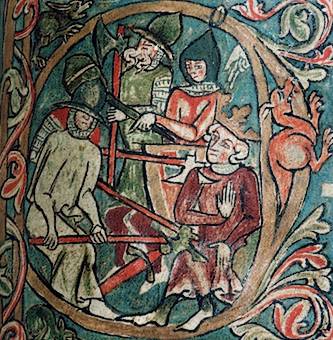
Amazon Audible Gift Memberships
Illumination from the collection of Icelandic sagas, the Flateyjarbˇk.
A 14th century manuscript
St Olaf Killed.
 Country of Origin: Iceland. Held by: Stofnun Arna Magnussonar a Islandi, Reykjavik, Iceland. Source: Werner Forman Archive. Country of Origin: Iceland. Held by: Stofnun Arna Magnussonar a Islandi, Reykjavik, Iceland. | |
| 982A-C | 'Death of St Olaf', Flateyjarbˇk, Iceland, late 14th century |
| (Manuscript Institute col. 310, Reykjavik, Iceland) | |
| Though strictly speaking dating from outside the period covered by this study, the illustrations in the Flateyjarbˇk shed an interesting light on the arms and armour of medieval Europe's most far-flung region. The warriors wear tall, conical chapel-de-fer war-hats. The sword (B) is a typical 14th century type with curved quillons and a round pommel. The men also wield axes that might have been included in the picture because they were mentioned in the text. Such weapons may, however, have remained popular in 14th century Iceland. Note that these axes have almost nothing in common with those supposedly found in North America. | |
|
Referenced on p.45, The Vikings by Ian Heath. Haraldsson (St Olaf) at the Battle of Stiklestad in 1030. Saint Olaf's Saga describes the event thus: 'Thorstein Knaresmed struck at King Olaf with his axe and hit his left leg above the knee. . . . Then Thore Hund struck at him with his spear, and the stroke went in under his ring-shirt and into his belly. Then Kalf struck at him on the left side of the neck.... These three wounds were the death of King Olaf, and after his death the greater part of the forces which had advanced with him fell with him.' | |
Back to Illuminations from the collection of Icelandic sagas, the Flateyjarbˇk
Back to the beginning: King Harold Fine-Hair cutting the fetters from the giant Dofri who was to become his foster father in folklore